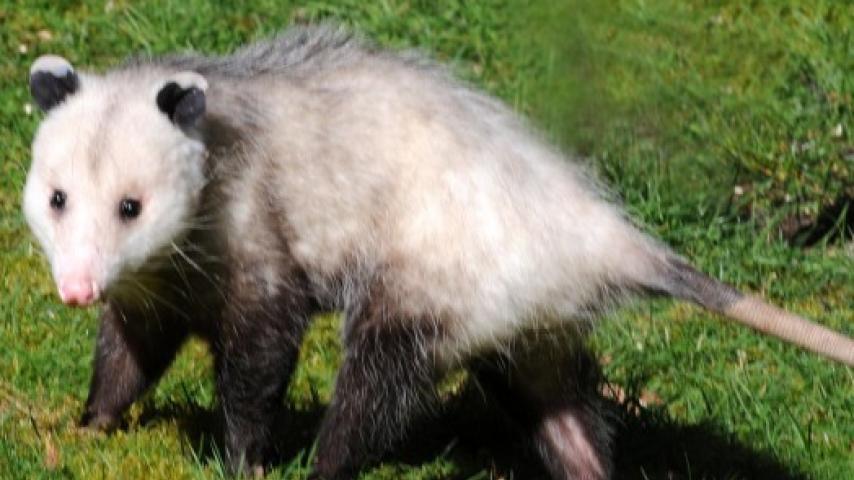Virginia Opossum (Didelphis virginiana)
Opossums are often thought to be big ugly rats.

KINGDOM Animalia - PHYLUM Chordata - CLASS Mammalia - ORDER Didelphimorpha - FAMILY Didelphidae
They are easily recognized by their moderate size (total length with tail about 75 cm) scraggly appearance, with long, unkempt but soft, whitish fur; a pointed, ratlike snout; and naked rounded ears. The long, scantily haired, pink-tipped tail is also ratlike, although somewhat prehensile. The sensory vibrissae (‘whiskers’) on the head are exceptionally long. When a ‘possum opens its mouth, however, the rat resemblance disappears, as the teeth look much like those of a carnivore, except more of them, 50 to be exact. This is the largest number of teeth of any North American mammal.
Opossums are marsupials, members of a subclass of mammals distinct from all others in North America, which are placentals. The young of placental mammals develop within the uterus of the mother and are nourished by a direct blood supply. Marsupial embryos, on the other hand, develop independently of the mother’s blood supply. They are born at a relatively undeveloped stage but are able to crawl from the birth canal to a pouch on the underside of the female, in this case backward pointing (unlike kangaroos), where they spend the rest of the time developing into tiny replicas of the adult.
Opossums are in reproductive condition for three-fourths of the year, which allows them to have two litters at our latitude. The young remain in the uterus for only about 12 days, then travel to the pouch, where each attaches to one of the mother’s nipples and remains attached for almost two months. They are then weaned after another month and a half. Most females breed during only one season; they die when two years old.
Most opossums inhabit a den site for a period of a few days, then move to another. This is usually a hollow log or tree or a burrow made by another mammal, but human structures also offer appropriate crevices.
The Virginia Opossum is the only marsupial occurring in the wild in North America and is surprisingly wide-ranging for an essentially tropical species. It has been introduced into and thrives in the lowlands west of the Cascades mountains all the way north into British Columbia. Its tropical origins are evident when individuals with frostbitten ears and tail are seen. Found in every wooded habitat, it seems especially common around urban and suburban areas, perhaps because there is much food and a reduced abundance of predators.
Possums eat just about any animal or plant food. Seeds and fruits of all kinds are taken, including hard-shelled nuts. Small animals from earthworms through insects to salamanders and snakes are common prey. Opossums are unusual in having a high degree of immunity to pit viper venom, thus putting those snakes into the prey category. Bird eggs and young are taken whenever found, and fresh carrion is common in the diet. Larger carnivores and large owls are their predators, but in settled areas, most are probably killed by automobiles. An opossum’s tendency to “freeze” in headlights can be its downfall.
Opossums are well known for “playing possum” when confronted by danger. Their behavior, doing absolutely nothing, makes it seem as if they are dead, very effectively supported by the mouth being partially open and the tongue hanging out. If not molested, after a while the animal gets up and beats a retreat.

